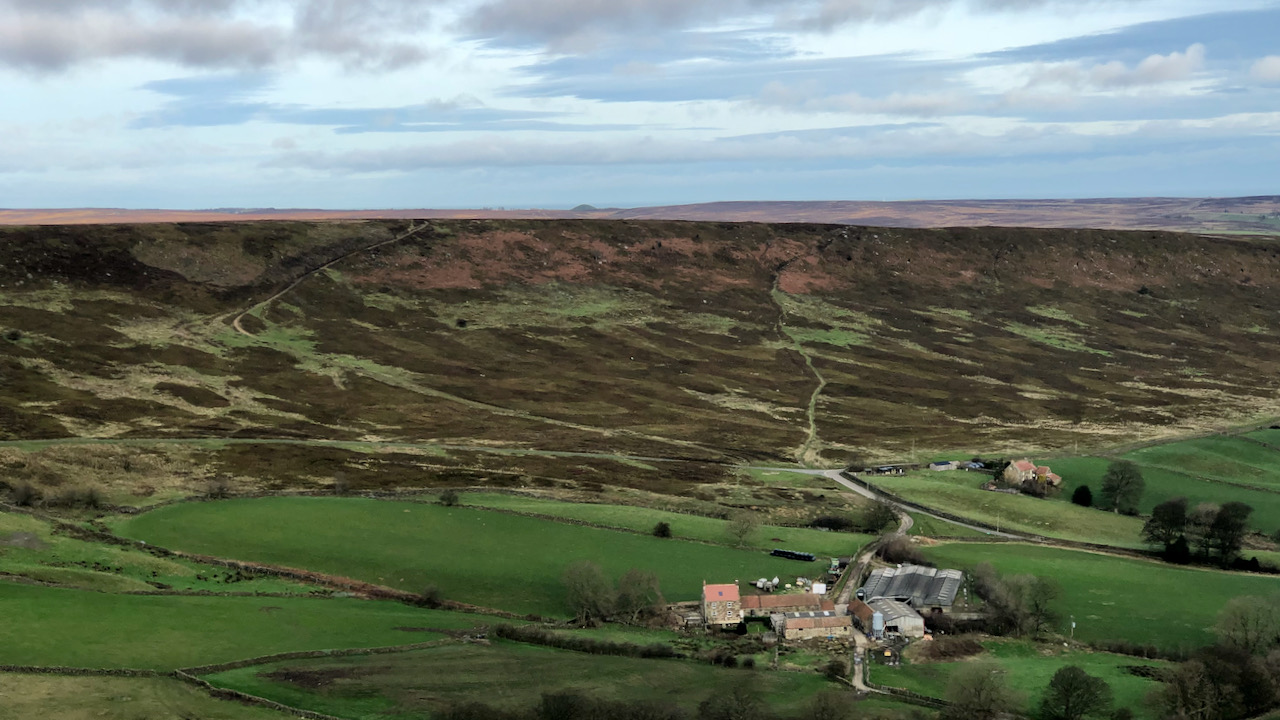Old ‘corpse roads‘ or ‘coffin paths‘ were the routes country folk used to carry the dearly departed to their final resting place. They lie subliminally somewhere between myth and memory, and go by other names, like ‘bier roads,’ ‘lych ways,’ and ‘church-ways.‘ The memory of these old paths perhaps became more intangible because of how they were used — carrying the dead. Maybe that’s why they’re not as easy to discern or don’t show up as much in the historical records compared to the ‘official’ routes like those grand Roman roads.
Prior to the 18th-century, ‘mother’ churches typically held the exclusive authority to oversee burials, a prerogative laden with substantial fiscal advantages. Consequently, it was routine to inter the dead at a considerable distance from their abode or the site of their demise, particularly in rural locales. The Fryup dales, in addition, found themselves bereft of a dedicated church, necessitating the transport of the casket across Ainthorpe Rigg into Danby Dale on the corpse road.
We can be certain that this track was indeed a ‘corpse road.’ It is marked as ‘Church Way’ on the first O.S. map, and the esteemed Reverend Canon Atkinson so attested1Atkinson, Rev. J. C. “Forty years in a moorland parish; reminiscences and researches in Danby in Cleveland.” Page 219. 1891.. He recounts the tale of an elderly woman residing in Fryup, whose primary claim to fame rested on the assertion that she maintained the “Mark’s e’en watch” on St. Mark’s day, which meant she could predict the deaths expected in the upcoming year. When queried about this matter following her vigil, she prophesied her own demise as one of the doomed ones. “And,” she added, “when I dee, for dee I s’all, mind ye carry me to my grave by t’ church-road, and not all the way round by t’ au’d Castle and Ainthrop. And mind ye, if ye de’ant, I’ll come again.”
The parson reveals that the path to the church goes right past the old lady’s house, heading straight to a very steep climb up the moor. This ascent, with its two zigzags, can be seen in the featured image — the track to the left. It is no walk in the park even on a normal day, but bearing a coffin with its grim tenant, and it’s not a job for the faint-hearted. As fate would have it, the old lady died just as she foresaw, and it’s right in the middle of a hard winter.
Navigating this track during a snowstorm was altogether a different kettle of fish. The pallbearers found themselves grappling with waist-deep snow, but undeterred, they soldiered on, hauling their load. They weren’t about to risk the possibility of the old biddy making a surprise comeback.
Corpse roads have become ingrained in tales of folklore, with their association with death and the spiritual journey beyond. Folklore which tell of ghosts, talking coffin-stones, and creepy corpse-candles. The first documented reference to these routes also hints at the spiritual realm they traverse, as expressed by Puck in William Shakespeare’s A Midsummer Night’s Dream2‘A Midsummer Night’s Dream by William Shakespeare | English Literature Course Notes | Tower Notes’. 2023. Towernotes.co.uk <https://www.towernotes.co.uk/literature-notes-1_Shakespeare_Midsummer-Night039s-Dream_3.php> [accessed 23 December 2023]:
Now the hungry lion roars,
And the wolf behowls the moon…
Now it is the time of night
That the graves, all gaping wide,
Everyone lets forth his sprite
In the church-way paths to glide.
And we fairies, that do run
By the triple Hecate’s team
From the presence of the sun
Following darkness like a dream…
One common belief surrounding corpse roads was that any path used for a coffin procession automatically became a public right of way. Despite the absence of legal backing for this notion, landowners in the 19th century went to the trouble of putting up signs to prohibit funeral processions from crossing their land.
- 1Atkinson, Rev. J. C. “Forty years in a moorland parish; reminiscences and researches in Danby in Cleveland.” Page 219. 1891.
- 2‘A Midsummer Night’s Dream by William Shakespeare | English Literature Course Notes | Tower Notes’. 2023. Towernotes.co.uk <https://www.towernotes.co.uk/literature-notes-1_Shakespeare_Midsummer-Night039s-Dream_3.php> [accessed 23 December 2023]

Leave a Reply